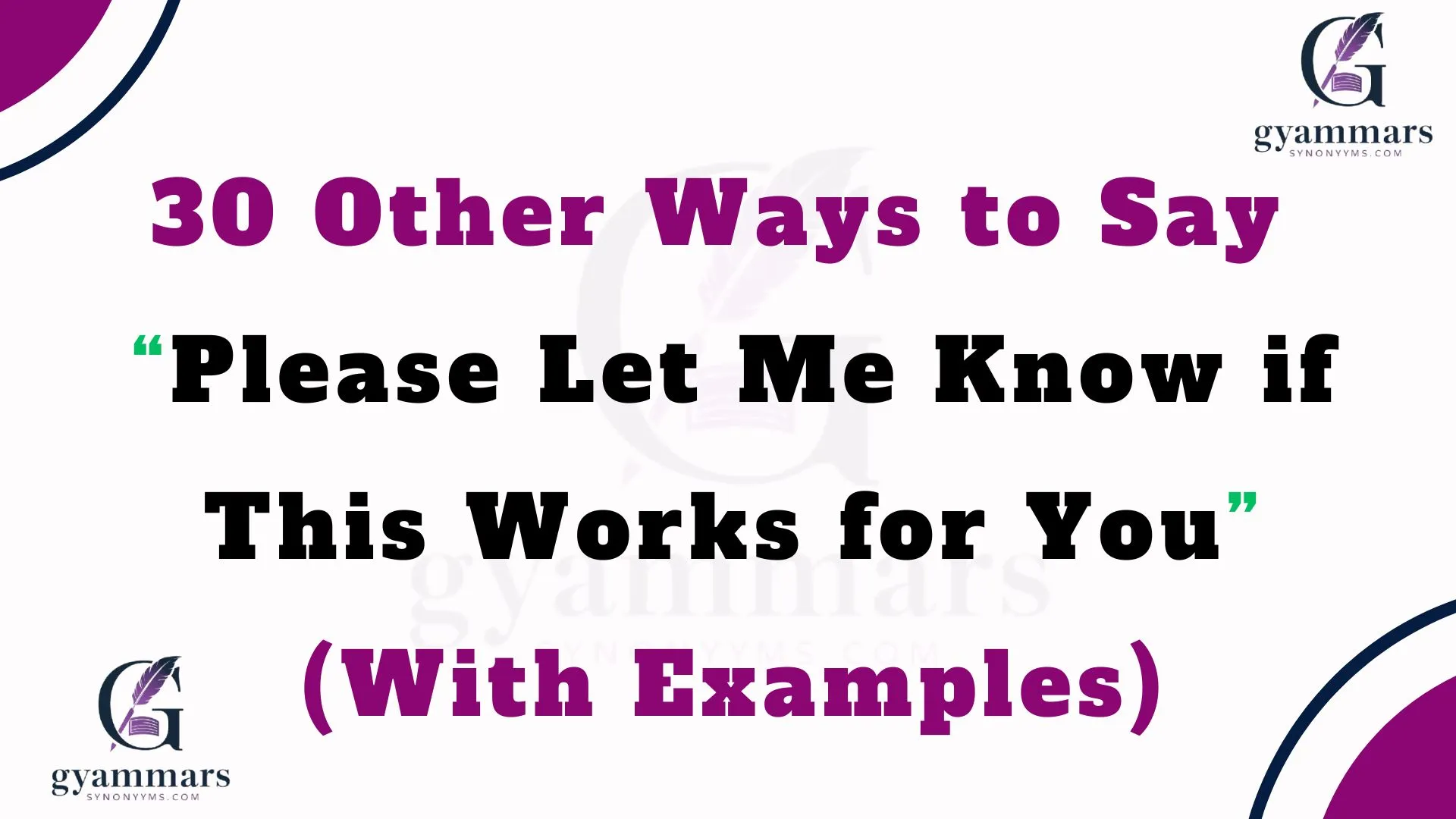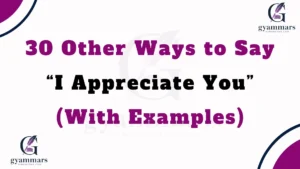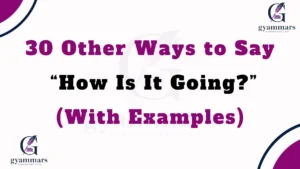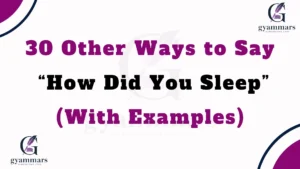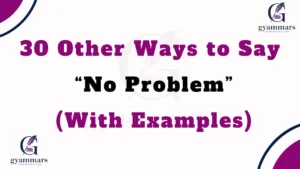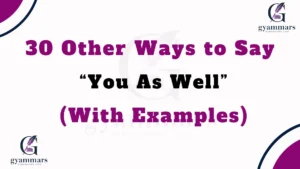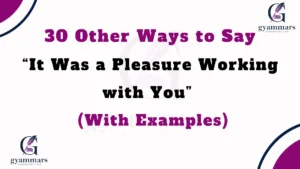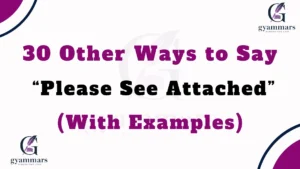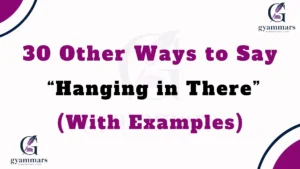Finding the right words to express care and consideration can strengthen communication and make interactions more warm and thoughtful. Whether you’re writing an email to a colleague, sending a message to a client, or simply checking in with a friend, using the right phrase can make all the difference. This guide will help you find meaningful alternatives that resonate with different situations and tones.
What Does ‘Please Let Me Know if This Works for You’ Mean?
This phrase is a polite and professional way of asking someone for their approval, feedback, or confirmation. It shows consideration and keeps the conversation open-ended.
Is It Professional/Polite to Say ‘Please Let Me Know if This Works for You’?
Yes! It’s a polite, respectful, and professional phrase suitable for workplace emails, business communication, and even casual conversations. However, alternative phrases can make your message feel more natural, engaging, and less repetitive.
Pros and Cons of Saying ‘Please Let Me Know if This Works for You’
Pros:
- Polite and professional
- Widely accepted in both formal and informal settings
- Clearly conveys the request for confirmation
Cons:
- May sound repetitive in frequent use
- Can feel overly formal in casual settings
- Lacks variety, making communication seem less engaging
Synonyms For ‘Please Let Me Know if This Works for You’
- Does This Work for You?
- Let Me Know if This Suits You
- I’d Love Your Feedback on This
- Do These Details Work for You?
- Please Confirm if This Works for You
- Would This Work for You?
- Feel Free to Let Me Know Your Thoughts
- If This Doesn’t Work, Let’s Find a Better Option
- Let Me Know What You Think
- Would You Be Okay With This?
- Let Me Know If That’s Good for You
- Please Advise If This Works for You
- Let Me Know Your Preference
- I’d Appreciate Your Feedback
- If That Works for You, Let’s Proceed
- Do Let Me Know Your Thoughts
- Let Me Know If This Is Suitable
- Hope This Works for You – Let Me Know!
- Please Confirm If This is Okay
- Looking Forward to Your Thoughts
- Would You Like Any Adjustments?
- Let Me Know If This Aligns With Your Plans
- Happy to Adjust If Needed – Let Me Know
- Does This Time Suit You?
- Let Me Know How This Works for You
- Let Me Know If This Meets Your Needs
- I’m Open to Any Suggestions – Let Me Know
- Kindly Confirm If This Works for You
- Let Me Know If Any Adjustments Are Needed
- Your Input is Valuable – Let Me Know Your Thoughts
1. Does This Work for You?
Definition: A direct way to ask if something is suitable.
Detailed Explanation: This phrase is short, clear, and professional, making it ideal for quick messages.
Scenario Example: “I’ve scheduled the meeting for 2 PM. Does this work for you?”
Best Use: Business emails, team discussions.
Tone: Professional, neutral.
Additional Notes: More concise than the original phrase.
2. Let Me Know if This Suits You
Definition: A polite way to check if something is acceptable.
Detailed Explanation: “Suits” makes the phrase sound slightly more formal.
Scenario Example: “I’ve suggested a few time slots. Let me know if this suits you.”
Best Use: Client communication, formal emails.
Tone: Professional, considerate.
Additional Notes: Great for business interactions.
3. I’d Love Your Feedback on This
Definition: Encourages the recipient to share their thoughts.
Detailed Explanation: Sounds friendly and collaborative.
Scenario Example: “I’ve drafted a proposal. I’d love your feedback on this.”
Best Use: Teamwork, project discussions.
Tone: Warm, inviting.
Additional Notes: Works well when seeking opinions.
4. Do These Details Work for You?
Definition: A straightforward way to check for agreement.
Detailed Explanation: Keeps communication precise.
Scenario Example: “The agenda is attached. Do these details work for you?”
Best Use: Work emails, project updates.
Tone: Direct, professional.
Additional Notes: Best for structured communication.
5. Please Confirm if This Works for You
Definition: A polite request for confirmation.
Detailed Explanation: More formal than the original phrase.
Scenario Example: “The call is set for Monday at 10 AM. Please confirm if this works for you.”
Best Use: Formal emails, business correspondence.
Tone: Respectful, professional.
Additional Notes: Works well in corporate settings.
6. Would This Work for You?
Definition: A softer way to check for agreement.
Detailed Explanation: Sounds less demanding than “Does this work for you?”
Scenario Example: “I’m available at 3 PM. Would this work for you?”
Best Use: Casual and professional communication.
Tone: Friendly, flexible.
Additional Notes: Best for conversational emails.
7. Feel Free to Let Me Know Your Thoughts
Definition: Encourages open dialogue.
Detailed Explanation: Makes the recipient feel valued and included.
Scenario Example: “I’ve suggested a location for our meeting. Feel free to let me know your thoughts.”
Best Use: Team discussions, collaborative projects.
Tone: Warm, engaging.
Additional Notes: Works well in brainstorming discussions.
8. If This Doesn’t Work, Let’s Find a Better Option
Definition: Shows willingness to adjust plans.
Detailed Explanation: Makes the message more flexible and cooperative.
Scenario Example: “I suggested Friday for the meeting. If this doesn’t work, let’s find a better option.”
Best Use: Negotiations, scheduling emails.
Tone: Accommodating, professional.
Additional Notes: Great for problem-solving conversations.
9. Let Me Know What You Think
Definition: A casual way to ask for input.
Detailed Explanation: Works well in friendly and professional settings.
Scenario Example: “I’ve sent over the proposal. Let me know what you think.”
Best Use: Informal emails, teamwork.
Tone: Conversational, warm.
Additional Notes: Best for quick check-ins.
10. Would You Be Okay With This?
Definition: A softer, more considerate way to ask for approval.
Detailed Explanation: Makes the recipient feel like they have a say.
Scenario Example: “I booked a table at 7 PM. Would you be okay with this?”
Best Use: Scheduling, friendly discussions.
Tone: Gentle, accommodating.
Additional Notes: Best for one-on-one conversations.
11. Let Me Know If That’s Good for You
Definition: A polite way to check for approval.
Detailed Explanation: Keeps the tone friendly while still requesting feedback.
Scenario Example: “I suggested 4 PM for our call. Let me know if that’s good for you.”
Best Use: Casual emails, friendly conversations.
Tone: Warm, approachable.
Additional Notes: Works well in less formal settings.
12. Please Advise If This Works for You
Definition: A formal way to ask for confirmation.
Detailed Explanation: Often used in business communication and emails to clients.
Scenario Example: “I have proposed the following dates. Please advise if this works for you.”
Best Use: Corporate emails, professional settings.
Tone: Formal, respectful.
Additional Notes: Best for official business correspondence.
13. Let Me Know Your Preference
Definition: Encourages the recipient to share their preferred option.
Detailed Explanation: Gives the other person a sense of control and flexibility.
Scenario Example: “We can meet at 10 AM or 2 PM. Let me know your preference.”
Best Use: Scheduling, decision-making discussions.
Tone: Considerate, collaborative.
Additional Notes: Great for offering choices.
14. I’d Appreciate Your Feedback
Definition: Expresses gratitude while asking for input.
Detailed Explanation: A polite and respectful way to invite responses.
Scenario Example: “I’ve put together a draft proposal. I’d appreciate your feedback.”
Best Use: Team collaborations, professional emails.
Tone: Warm, appreciative.
Additional Notes: Best when seeking detailed input.
15. If That Works for You, Let’s Proceed
Definition: A smooth transition from checking approval to action.
Detailed Explanation: Keeps things efficient and professional.
Scenario Example: “I have scheduled the call for tomorrow at 3 PM. If that works for you, let’s proceed.”
Best Use: Work discussions, decision-making emails.
Tone: Confident, professional.
Additional Notes: Good for finalizing plans.
16. Do Let Me Know Your Thoughts
Definition: A slightly more formal way to ask for input.
Detailed Explanation: Encourages a response without being too demanding.
Scenario Example: “I’ve shared the report. Do let me know your thoughts.”
Best Use: Formal and semi-formal communication.
Tone: Polite, thoughtful.
Additional Notes: Works well for both work and personal use.
17. Let Me Know If This Is Suitable
Definition: Checks if something meets the recipient’s needs.
Detailed Explanation: Sounds polite and accommodating.
Scenario Example: “We have booked the meeting room at 1 PM. Let me know if this is suitable.”
Best Use: Business communication, scheduling.
Tone: Professional, neutral.
Additional Notes: Ideal for flexible arrangements.
Also Read This: 30 Other Ways to Say ‘With That Being Said’ (With Examples)
18. Hope This Works for You – Let Me Know!
Definition: A friendly way to check for confirmation.
Detailed Explanation: Keeps the message lighthearted and engaging.
Scenario Example: “I’ve made a few adjustments to the plan. Hope this works for you – let me know!”
Best Use: Casual emails, friendly discussions.
Tone: Positive, conversational.
Additional Notes: Great for informal work settings.
19. Please Confirm If This is Okay
Definition: A direct yet polite request for approval.
Detailed Explanation: Ensures clarity while keeping it respectful.
Scenario Example: “We have adjusted the timeline. Please confirm if this is okay.”
Best Use: Work-related emails, project updates.
Tone: Professional, direct.
Additional Notes: Best for formal responses.
20. Looking Forward to Your Thoughts
Definition: Encourages the recipient to share feedback.
Detailed Explanation: Sounds enthusiastic and inviting.
Scenario Example: “I’ve outlined a few options. Looking forward to your thoughts!”
Best Use: Brainstorming, teamwork.
Tone: Engaging, warm.
Additional Notes: Great for collaborative projects.
21. Would You Like Any Adjustments?
Definition: A flexible way to check for needed changes.
Detailed Explanation: Gives the recipient a choice while keeping it polite.
Scenario Example: “I’ve proposed the final schedule. Would you like any adjustments?”
Best Use: Editing, revising work.
Tone: Accommodating, professional.
Additional Notes: Ideal for fine-tuning details.
22. Let Me Know If This Aligns With Your Plans
Definition: Ensures the suggestion fits their schedule.
Detailed Explanation: Works well for coordinating schedules.
Scenario Example: “We have booked the flight for next Friday. Let me know if this aligns with your plans.”
Best Use: Travel, business scheduling.
Tone: Professional, considerate.
Additional Notes: Great for long-term planning.
23. Happy to Adjust If Needed – Let Me Know
Definition: Shows flexibility and willingness to make changes.
Detailed Explanation: Keeps the conversation open and accommodating.
Scenario Example: “I reserved a table for 7 PM. Happy to adjust if needed – let me know.”
Best Use: Casual and professional settings.
Tone: Friendly, and adaptable.
Additional Notes: Encourages collaborative decision-making.
24. Does This Time Suit You?
Definition: A simple way to check availability.
Detailed Explanation: Keeps the message concise and professional.
Scenario Example: “I scheduled the meeting for 10 AM. Does this time suit you?”
Best Use: Scheduling emails, and work meetings.
Tone: Formal, polite.
Additional Notes: Best for efficient communication.
25. Let Me Know How This Works for You
Definition: A slight variation of the original phrase.
Detailed Explanation: Keeps things natural and polite.
Scenario Example: “I’ve sent over the contract. Let me know how this works for you.”
Best Use: Business agreements, professional discussions.
Tone: Courteous, adaptable.
Additional Notes: Great for business transactions.
26. Let Me Know If This Meets Your Needs
Definition: Ensures that the proposal or plan aligns with expectations.
Detailed Explanation: A polite way to check if the recipient is satisfied with the arrangement.
Scenario Example: “We’ve drafted the report based on your requirements. Let me know if this meets your needs.”
Best Use: Work-related discussions, and business negotiations.
Tone: Professional, accommodating.
Additional Notes: Ideal for service-based communication.
27. I’m Open to Any Suggestions – Let Me Know
Definition: Encourages feedback and collaboration.
Detailed Explanation: Shows flexibility and openness to changes or improvements.
Scenario Example: “Here’s the initial plan. I’m open to any suggestions – let me know.”
Best Use: Brainstorming sessions, creative projects.
Tone: Friendly, inclusive.
Additional Notes: Best for collaborative discussions.
28. Kindly Confirm If This Works for You
Definition: A formal way to ask for confirmation.
Detailed Explanation: Keeps the message polite and direct, commonly used in emails.
Scenario Example: “We have scheduled the meeting for 2 PM. Kindly confirm if this works for you.”
Best Use: Professional emails, official communications.
Tone: Formal, respectful.
Additional Notes: Suitable for corporate settings.
29. Let Me Know If Any Adjustments Are Needed
Definition: Invites the recipient to request changes if necessary.
Detailed Explanation: Emphasizes flexibility and willingness to make changes.
Scenario Example: “I’ve booked the venue for Friday. Let me know if any adjustments are needed.”
Best Use: Event planning, project management.
Tone: Accommodating, professional.
Additional Notes: Useful when offering modifications.
30. Your Input is Valuable – Let Me Know Your Thoughts
Definition: Highlights the importance of the recipient’s opinion.
Detailed Explanation: Expresses appreciation while encouraging a response.
Scenario Example: “We’re finalizing the design. Your input is valuable – let me know your thoughts!”
Best Use: Feedback requests, decision-making discussions.
Tone: Respectful, appreciative.
Additional Notes: Ideal for team collaboration.
Conclusion
Choosing the right phrase can make communication more engaging, polite, and effective. Whether you’re sending an email, scheduling a meeting, or finalizing a deal, these alternatives help maintain warmth and clarity in your messages.
FAQs
1. Why should I use alternatives instead of saying “Please let me know if this works for you”?
Using alternatives can add warmth, professionalism, or variety depending on the context. It helps tailor your communication to sound more engaging, considerate, or formal, based on the situation.
2. What is the most professional way to ask for confirmation?
If you’re in a formal setting, phrases like “Please confirm if this works for you” or “Is this acceptable for you?” are great options that maintain clarity and professionalism.
3. What’s a polite and warm way to check if something is okay?
For a more friendly and empathetic tone, you can use phrases like “Let me know if you’re comfortable with this” or “I’d love to hear your thoughts.” These create a supportive and open dialogue.
4. Can I use these alternatives in both personal and professional settings?
Yes! Some alternatives work best in business settings (e.g., “Would you be open to this?”), while others are ideal for casual conversations (e.g., “Just checking if this works for you.”).
5. How can I make my request sound more inviting and collaborative?
Using phrases like “I’d appreciate your input on this” or “Please share your thoughts on this” makes your request feel more engaging rather than just seeking a yes/no response.

“Emma Rose at Grammar Synonyms is your go-to expert for everything related to language and expression. Whether you’re refining your grammar, searching for the perfect synonym, or looking for creative ways to improve your writing, Emma Rose provides the tools and inspiration you need. With a wide range of resources designed to elevate your communication, Grammar Synonyms helps you find just the right words to make every sentence shine.
